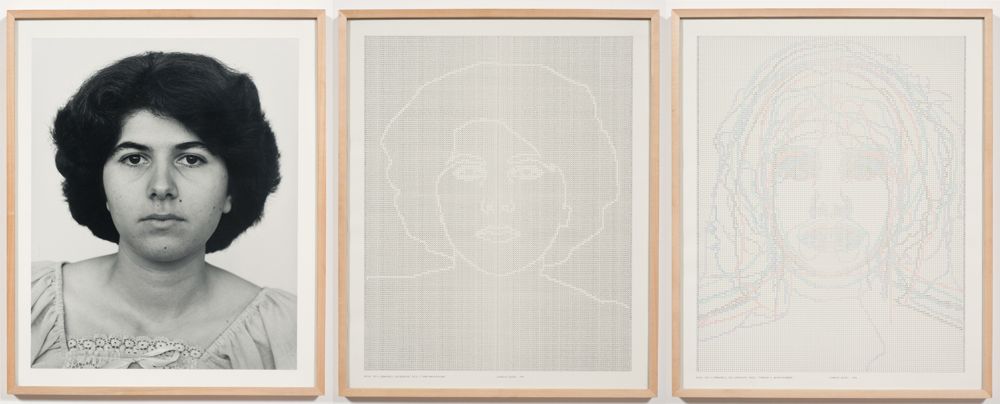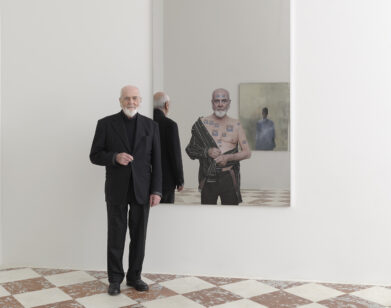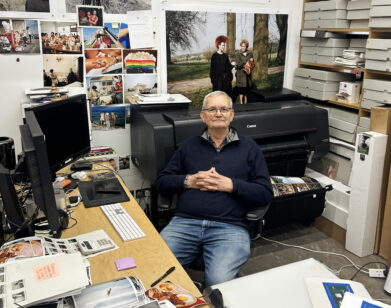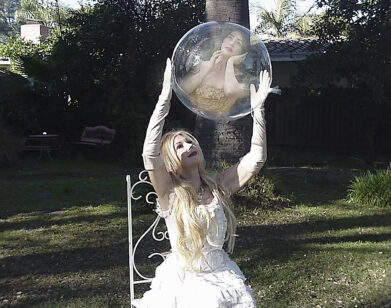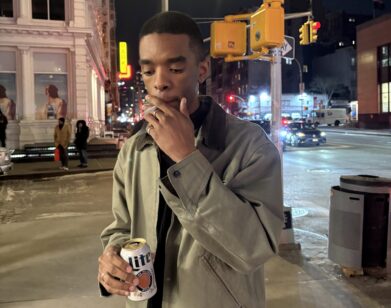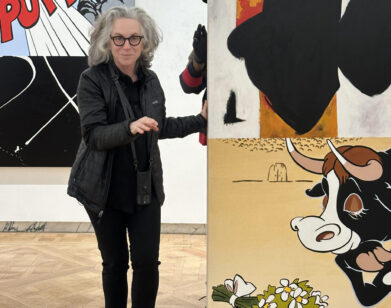In Practice: Charles Gaines x Malik Gaines
Soon after artist Malik Gaines hopped on a phone call last week with his father, Charles, he did much of the work of this introduction for us.
“I guess we should say that this is on the occasion of your survey exhibition at the Studio Museum in Harlem, which is long in coming and a beautiful show, and covers some of your influential conceptual and language-based work from ’74 to ’89,” Malik summarized, before offering a singularly personal addendum: “Which happens to be my entire childhood.”
Aesthetically, the work of the elder and younger Gaines wouldn’t seem to have much in common. Throughout a four-decade career, Los Angeles-based Charles has worked in photography, drawing, and painting, often performing “regressions” of real-life imagery (faces, trees, the body in motion) painstakingly onto grids, pixilating and abstracting the source material. Malik, by contrast, is a performance artist best known for his work with My Barbarian, the experimental-theater trio most recently notable for its participation in this year’s Whitney Biennial. But when it comes to the concerns that fuel their art-making—identity and racial construction; communication, language, and its limitations; the invention and critical examination of art practices—the apple doesn’t fall far from the tree, as the two men discovered through the course of their conversation. —Alexandria Symonds
MALIK GAINES: When the museum had a dinner for you, Thelma Golden made a really touching and heartfelt speech giving you, basically, credit for everything that has happened at the Studio Museum. [laughs] Or at least saying that your work has laid a foundation for so much of the projects that she’s done there over the past more than 10 years, and certainly a lot of people who have been your students and have been really influenced by you have been the artists who have been important in that museum, including myself.
CHARLES GAINES: I had no idea that Thelma had regarded the influence of my work that way. So I was shocked. She had the whole place in tears, me included. The Studio Museum show is a serious public acknowledgement of something that I thought nobody was paying attention to.
MALIK GAINES: Right.
CHARLES GAINES: And quite frankly, I never thought that anybody would. It wasn’t something that I was thinking about daily. What I was thinking about daily was trying to produce work, and the struggle of the relationship of that work to some of the critical and conceptual ideas that I have about it, which seem to have a certain degree of controversy. I wasn’t really thinking about public acknowledgement—I’m not trying to be hyper-cool or anything, like that stuff doesn’t matter to me, because it does matter to me. It’s just that it was something that I didn’t think would happen, so I just didn’t think about it. I had very little exposure in New York in the last decade, up until the Paula Cooper show [last year], so I began thinking that after all those years of being in the shadows, so to speak, some serious public exposure is beginning to happen. With the Studio Museum show, that thought is becoming even more present in my mind—and suddenly, and like a landslide, having to think about it. I’m still sort of in a daze.
MALIK GAINES: The Studio Museum in Harlem has a mission and a mandate and an interest in thinking about African-American artists, and some of the press has been about the relationship of your work to later generations, where identity politics and critical representations of race became gradually more visible in the mainstream art world. Your work, of course, came before that. And some of the press has been about how the social problem of being a black artist relates to your work, which wasn’t really representing that problem explicitly (although one might say that the critical representation of language and structures of meaning of course is inclusive of race and inspired by the problems of racial representation). So many people have been inspired by you on that level, but back at the time, your work wasn’t really thought of in that context, necessarily. Do you think this is a valuable way to think about that work—returning through history to what’s happened?
CHARLES GAINES: I have so many thoughts about that. I don’t even know where to begin. This is talking back to where I was in the ’70s. If I can say anything, I would say that my interests were around broad ideological concepts that somehow focused on the idea of invention and change and probably were influenced by modernism. But I really, really was interested in art as a way of dealing with broad cultural ideas or philosophical ideas, so that art would be used as a critical element or a critical tool of investigation of those things. So certain things always popped up, which made me think about race.
I think my interest in that was just driven by my experience growing up in the South as a very young child and being aware of segregation and understanding racial segregationist theory as a child and being very invested in the idea of, “Why am I placed in this predicament?” I didn’t articulate it that coherently as a four-year-old, but on some level I think I was interested in the parameters and limits that place people in the world in certain locations and contexts, and particularly when those locations are negative. So the idea of change, which is linked later to the idea of the avant-garde in my mind, I think was something that was stimulated by my social location.
What I just told you wasn’t a factor in my thinking in the early and middle ’70s. It hadn’t developed that far. But I did know that I was interested in these broad theoretical, ideological ideas and frameworks and interrogating them through art. But then, all this stuff about race kept happening. When I started showing in New York, my name got out there, but nobody knew I was black, and then I started going to parties or to lectures or I’d be interviewed, and I can’t tell you how many times people have come up to me and said, “You’re black.” “I really appreciate you informing me. I know.” [both laugh] I was in a show and the curator of the show did not know I was black, and then when they saw me at the opening—you know those spaghetti Westerns where the saloon is partying and then the guy in the white hat walks into the saloon?
MALIK GAINES: Right through the swinging doors.
CHARLES GAINES: Yeah, yeah, the swinging doors, and then the piano stops playing. The silence. It was literally that: I would walk into a space and the piano would stop playing. And these things were happening, so I knew that the question of race was present to me. I know that some artists take the position that art is beyond race—black artists said that, even Raymond Saunders made that comment. And race was seen by many artists as a limiting factor: if they focus on the fact that you’re black, then you won’t be able to be seen and respected as an artist. So they wanted to disassociate with the ideas of race, and I did not want to do that. But I didn’t know how my interest in broad conceptual ideas was related to it. So eventually I took the position that, well, somehow my experience as a black person is inescapably linked to my work, my practice—something that’s a little bit more sophisticated, more critically forceful, than the idea that my work is black art because I’m black. At the time I couldn’t think of how to articulate it, and it wasn’t until later that I began to be able to conceptualize what that relationship could be.
MALIK GAINES: Right.
CHARLES GAINES: It’s a long answer, but it’s a complicated question. In the late ’80s and early ’90s, I did have a critical notion about it that also had influenced a change in my work: I went from using systems exclusively to going into language. I found that going into language still deals with issues of chance and issues of ideology and representation. I could deal with those through social subjects and social constructions.
MALIK GAINES: Right, and growing up around those works, I came to understand very early that these particular questions aren’t eccentric or marginal or obscure within language. Problems of difference and representation are language. [both laugh] That is what language is made of. That’s an act. That’s the sign. That’s all of the things that we understand as language, and race is not some kind of odd biological characteristic of certain people, but it’s completely connected to the way we think and process and understand everything.
CHARLES GAINES: I have a question for you, which I have never asked you. Don’t get nervous.
MALIK GAINES: [laughs] Now, on tape, you’re going to ask.
CHARLES GAINES: That’s right. I’m putting you on the spot, because I’ve watched your practice evolve. It works through performance and writing and theorizing and so forth, and I don’t really separate any of those parts. And at the same time, I remember bringing you to the studio when you were eight or nine years old and your not being very happy about it. Which is normal, because if I were a nine-year-old being dragged to my father’s studio, I wouldn’t have been very happy about it either. But it seems that your evolution into a formed art practice happened not so much by the many things you’ve experienced as a kid in the art world, but by autonomous stages that came together. People ask me all the time, “Oh, you must be so happy, your son is a very important artist and writer. You must have seen that.” I say, “I didn’t see it!”
MALIK GAINES: [laughs] Why not?!
CHARLES GAINES: Well, like I said, the way it unfolded was unique. It’s not like me, where I did these drawings and everyone was telling me, “Oh, you should be an artist.” It was something that you evolved and constructed over the years, from your teenage years all the way into young adulthood and so forth.
MALIK GAINES: Sure.
CHARLES GAINES: And the second part of that, I think, has to do with what influenced you. I remember that the friends that you hung around with were a very diverse population of people, and you were attracted to that diversity. So I’m also asking you to take a critical look, a way of thinking, about that.
MALIK GAINES: I have a couple ways of answering that. One, since we’ve been at these events for your show and since I’ve been present, I’ve been really happy and engaged: I wrote an essay for the catalogue, and this is the work I grew up around in the house. People ask me, “What’s it like to have an artist for a father and be an artist yourself? That must be really extraordinary.” And I think for a lot of people who become artists, like yourself, there’s some kind of break from what your family would think about or understand or care about or expect you to do. In one sense, it’s actually very conventional for a son to go into the same business as his father. [laughs] We’re both artists, and we’re both professors in art programs and so it’s almost embarrassing how conventional it is, what I’ve done.
And another way, I think it was wonderful to have that kind of exposure—I think I was the only five-year-old mixed kid from California at Leo Castelli Gallery, hanging out. It was quite an education, and seeing your work, in addition to my mother’s work, I learned a lot about that kind of patient practice. There was one time when My Barbarian was selling giant text banners, and so I was sewing letters on fabric, and I thought, “Oh my God, this is a complete combination of what I saw my parents doing.” [laughs] You, endlessly drawing numerals and letters all over everything, and my mother sewing. I somehow synthesized it, and like you were saying, it wasn’t really conscious.
People ask me this question and I’m like, “Well, at least I don’t have to worry about just replicating Charles Gaines,” because of course, My Barbarian’s work is very different from your work in some crucial formal and other ways. But a curator said to me, “Well, I don’t know.” Interestingly, all the things that your systems tend to put critical pressure on, such as expressivity and subjectivity, those are the things that are up front and center in My Barbarian’s theatrical projects. So someone said they actually saw a relationship there—maybe that’s an Oedipal relationship, where I’ve taken everything that you’ve tried to put under critical pressure and made it the centerpiece of my work.
There was a panel a couple months ago that the incredible Carrie Mae Weems put together at the Guggenheim, and you were on a panel of people that she had assembled who she had declared as influential to her and important artists of a certain age. You were the youngest, but you were there with some senior influences, and I was really struck that each of you, particularly as black artists, but as artists, really just had to make up your own shit. You just went out there and said, “I’m doing this thing. No one else is doing it, no one’s even heard of it, maybe no one cares about it, but this is what I’m doing. I’m committed. This is my project. This is my practice. I’m doing it. I’m doing it forever.” As an artist, seeing that kind of example is really important, because many young artists think, “I’ve got to make it when I’m 20, I’ve got to make it when I’m 30.” This is on the social, practical side of trying to be an artist in this world. I’ve seen you go through decades where you’re having important galleries, decades where you’re doing important critical work, decades where you’re writing, times when you are having museum retrospectives and times where you are not active in that way. Through all of that was the idea that an artist is someone who’s committed to a project and a practice and just keeps going until they figure out what to do next. It’s a very strong example that you’ve set—not just for me, but for other students of yours and a lot of people. Who can say? I could have had a dentist father and come up with the same things. I doubt it.
CHARLES GAINES: Well, it probably explains a lot beyond this idea that anything you do, just because you’re my son, is perfect. Beyond that, what is interesting to me in what you’re saying, because I didn’t think about it before, is how you actually invented a practice. My Barbarian is truly an invented practice. And you’re inventing strategies and ways for its production and its receptions.
MALIK GAINES: I’m not embarrassed to take some credit for that. I mean, I think the shift towards performance, we’ve come up with it and in some ways have helped open up some spaces.
CHARLES GAINES: Yeah, and I can’t help link that to the old avant-garde strategy of invention, because what you said about what’s going on with me in the ’70s, it was that making works weren’t moments of accomplishment. Once one work is produced, it was uncertain kinds of tests, where my experiments revealed stuff that I could or couldn’t deal with.
In the catalogue, you said something interesting about when I was part of an exhibition in Munich, “Process und Konstruktion,” and I was not trying to be framed by simply issues of race, and so when I did these map paintings of Africa in Germany, for everyone, the subject then was race. I was offended—is that all they’re seeing, issues of race? But at the same time, as you pointed out, the work, dealing with these broad constructions, had to take in subjects that are specific to culture, and for a long time I couldn’t figure out how to deal with that, and I learned that I shouldn’t ignore that. So that’s something that the work exposed to me. I had to find ways of remapping, because I couldn’t predict those locations in the practice itself. So I took this as a general idea that the avant-garde has expounded and interestingly, in the evolution of My Barbarian over all these years, I saw a certain constant remapping going on as you guys are experimenting with the strategies of performance. I really identified with that.
MALIK GAINES: Apart from the gratifying recognition that people are giving you, how does it feel to see all of this work together that hasn’t been together in decades? I remember as a kid going to your shows and there would be these tremendously long series of systematic works that were just beautifully [displayed] around an entire gallery. And then what we’ve seen over the years is just one here and one there. It must be a life-before-your-eyes moment, seeing a lot of that work collected again in one space.
CHARLES GAINES: Yeah, I can’t quite figure out my response yet. One thing I was thinking is, well, this work looks fresh to me, and it doesn’t look like it’s located in the ’70s, and part of that might have to do with the fact that I’ve never seen it assembled like that before. Do you remember that Roxana, my wife, gave me a surprise birthday party a while back? She secretly arranged for my sister to fly up from New Jersey to attend the party. I was working in the studio, and you guys came and very sneakily said, “We have a guest for you in town to see.” And I turn around and my sister walks in. For about 30 seconds, I did not know what to think. Essentially language just falls apart; you’re so surprised, and you’re trying to fit parts together that don’t go together. It was my sister! What’s she doing here? Where am I? No, she can’t be here. Yeah, it is her! So that’s the kind of moment that I’m in. Maybe not as intense as it was in those few seconds—it’s expanded. But it’s trying to deal with things that are very important to you and you spent so much time developing and now you’re called to revisit it.
MALIK GAINES: Well, here’s to decades more. And of course this means that I also will have a great retrospective 30 years form now, so that’s encouraging. [laughs]
CHARLES GAINES: [laughs] I’ll be there!
CHARLES GAINES: GRIDWORK 1974-1989 IS ON VIEW THROUGH OCTOBER 26 AT THE STUDIO MUSEUM IN HARLEM. FOR MORE ON THE EXHIBITION, CLICK HERE.

